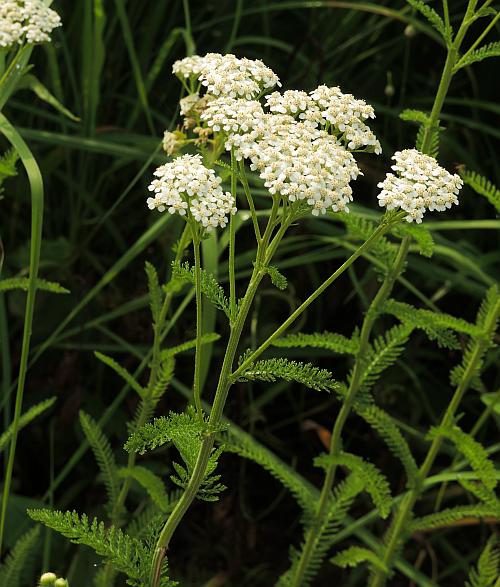Achillea millefolium L.
Yarrow

Native
CC = 1
CW = 3
MOC = 97
© HNourse
Achillea millefolium L.Yarrow | |
 |
Native CC = 1 CW = 3 MOC = 97 |
© HNourse |
|
Family - Asteraceae/Anthemideae Habit - Rhizomatous perennial forb. Stems - Erect, to 80 cm, herbaceous, sparsely to densely wooly-pubescent, branching in upper half, erect, fragrant when crushed.
Leaves - Alternate, sessile or short-petiolate. Blades 1-12 cm long, narrowly oblong to lanceolate or oblanceolate, deeply 2-3 times pinnately lobed, pinnately veined, glabrous or sparsely to densely pubescent with woolly hairs, the ultimate segments 1-3 mm long, linear to threadlike, sharply pointed at the tip, 1-veined. Basal leaves to 25 cm long.
Inflorescence - Flat or domed terminal cymose arrangement of flower heads.
Heads - Involucre 4-5 mm long, narrowly cup-shaped to nearly cylindrical. Phyllaries in 2-3 series, with scarious margins, woolly pubescent, imbricate. Outer phyllaries shorter than inner. Receptacle convex to hemispheric.
Florets Ray florets usually 5 per head, the corolla 2-4 mm long, often with minute, yellow, club-shaped glands, clawed, white, rarely pink. Expanded portion of ligule 3 mm long, 2-3 mm broad, emarginate or shallow 3-toothed at apex. Claw 2 mm long, greenish, glandular. Disc florets perfect, 10-20, the corolla 1.8-3.5 mm long, usually with sparse, minute, yellow, club-shaped glands, white to grayish white. Pappus absent.
Fruits - Achenes 1-2 mm long, oblong-obovate, flattened, broadly rounded to nearly truncate at the tip, the margins somewhat thinner and sometimes appearing as blunt wings, the surface smooth, glabrous, tan to light brown with lighter margins. Flowering - May - November. Habitat - Prairies, glades, forest openings, pastures, fields, roadsides, railroads, open disturbed sites. Origin - Native to the U.S. and Europe. Lookalikes - Distantly, Daucus carota and some other Apiaceae members. Other info. - This species is common across Missouri and nearly all of the U.S., uncommon only in a few deep southern states. It is easily recognized even when vegetative by the frilly leaves, which are strongly aromatic when crushed. Although Yatskievych states that the odor is unpleasant, this is a judgment call, and indeed the plant and others in the same genus have been used to brew herbal teas.
Yarrow has been called "nosebleed," presumably for a putative ability to initiate nosebleeds. Steyermark tested this hypothesis by stuffing the foliage up his nostrils, and reported that A. millefolium caused no irritating or burning sensation and thus was ineffective for this purpose. An ancient name was herbal militaris, derived from its use in stanching the flow of blood from wounds. The plant has a long history of use as a medicinal and flavoring agent. Its chemistry is also interesting. The blue hydrocarbon chamazulene, which it produces, is an unusual example of an aromatic system which contains no 6-membered rings. The plant is reportedly toxic to dogs, cats, and horses. Photographs taken at Hermes Nursery, Kansas City, Kansas, 07-14-00, and in the Ozark Scenic Riverways, Shannon County, MO., 5-24-03 and 6-16-05 (DETenaglia); also at Missouri Botanical Garden, St. Louis, MO, 7-3-2006, Shaw Nature Reserve, Franklin County, MO, 5-9-2007, 6-12-2007, and 5-27-2015 (SRTurner), and and at Shaw Nature Reserve, Franklin County, MO, 6-3-2019 (Hugh Nourse). |